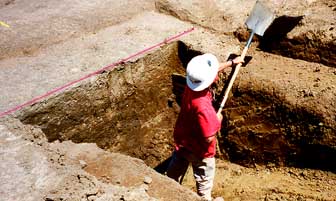|
- Home
- A Woolen Mills Chinatown Arch Jnl-1
A Woolen Mills Chinatown Archaeologist’s Journal -1
By Rebecca Allen, Ph.DWeek of April 26, 1999: Is Archaeology Glamorous?
After months and months of planning, waiting for Mother Nature to stop raining, and getting all permits in place, Caltrans and their archaeological consultants have begun the excavation of the site of the Woolen Mills Chinatown in San Jose, California.
Research
Before we hit the field, our project historians spent a lot of time researching the project area, finding all the nooks and crannies of local repositories of information, such as the history museums, libraries, and county government offices. All of this research was necessary to provide a context or setting for the artifacts that we expect to find. Provenience, knowing the exact location of where an object came from, is a mantra for an archaeologist. Without direct associations to historic events or people, objects from the past have a limited story to tell. Without provenience, the artifacts that we find have no meaning, and so we tightly control our excavations. In our view, bottle hunting is a sin (not to mention a federal crime), as it robs the past of its ability to tell us about history.
Planning and Preparation
So first we plan. Getting a large-scale excavation going means not only doing research, it means pulling together a well-qualified crew. Hiring a crew means finding a hotel, and a reasonably priced one at that, no mean feat in San Jose. We also have to find a backhoe (yes, a backhoe – many historic features are buried under later fill), a storage locker for equipment, a fencing crew to fence in and protect the site, and a security guard to stand watch when the crew goes home at night. Then the sifting screens have to be repaired, shovels cleaned up, trowels sharpened, and hard hats found for everyone on the site.Exploring with a BackhoeI’m sitting in our field trailer now, watching over the field where once there was a thriving Chinese community. The backhoe is roaring, and clearing the site of vegetation. All of our pre-field planning and research has told us where the Chinatown lays. Or at least we think so. After two days of exploring with the backhoe, the Chinatown appeared about 15 ft. off from where we thought it would, based on historic maps. Not bad for this game. Archaeology is about good solid research, accompanied by intuition that comes from reading the soil. The ProcessWhat next? We excavate with a crew of archaeologists working alongside a backhoe or two. This is really the second phase of a long process. Excavation is only about 10 percent of an archaeological project. The first phase was the pre-field research. Next is the actual excavation, and continuing research based upon what we find in the field. Then all artifacts are sent to a laboratory, where they are washed, sorted, pieced back together, identified, and analyzed. The Lab Director keeps an eagle eye out to make sure no artifacts are separated from their provenience. After lab work, we have to make sense of it all: the artifacts, the stratigraphy of the soil, and the documents. We spend many hours in front of a computer compiling information and writing reports. |
Is Archaeology Glamorous?
Sometimes it takes a lot of muscle! Do You Have Something to Add?Oh, and if anyone out there has family stories to tell of the Woolen Mills Chinatown, or photographs of the town and the people who live there, PLEASE let us know. Just send a note to info@chcp.org.
Keith Warren and Anmarie Medin in hardhats exposing a brick foundation
Working with Caltrans are archaeological consultants from the firms of Past Forward, Inc., KEA Environmental, Inc., Foothill Resources, Inc., PAR Environmental, Inc., and the University of California, Chico. |



 Well, let’s just say that Hollywood’s Indiana Jones would probably exit stage left pretty darn quickly. Do our hearts race with anticipation every time we find an unusual artifact or figure out another piece of the archaeological puzzle? You bet. We hope to share our enthusiasm for this archaeological site with you over the next few weeks.
Well, let’s just say that Hollywood’s Indiana Jones would probably exit stage left pretty darn quickly. Do our hearts race with anticipation every time we find an unusual artifact or figure out another piece of the archaeological puzzle? You bet. We hope to share our enthusiasm for this archaeological site with you over the next few weeks.